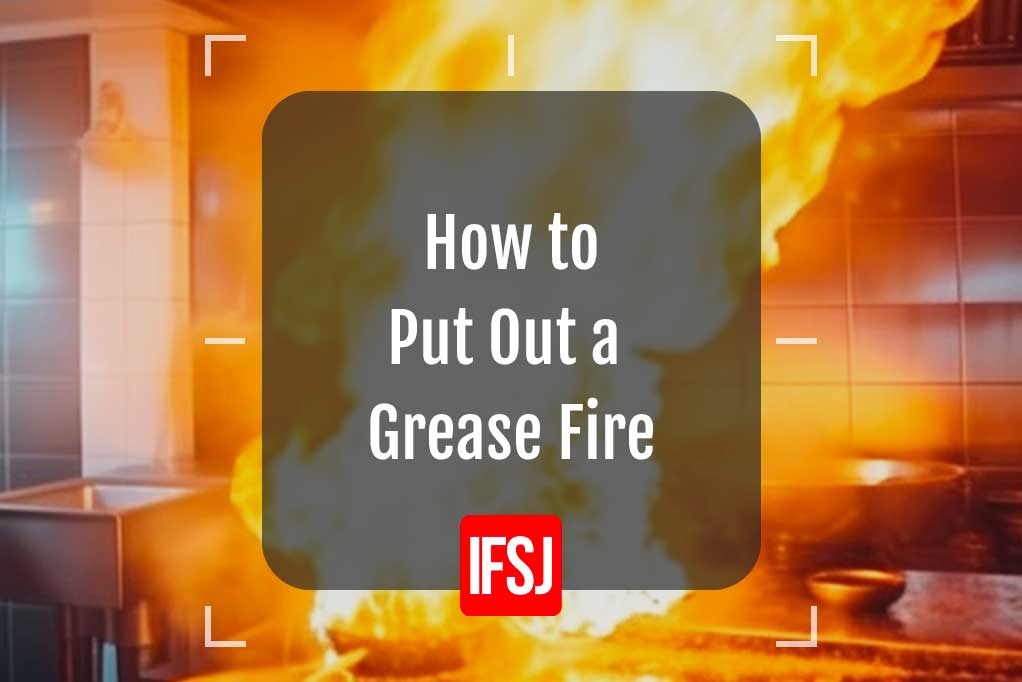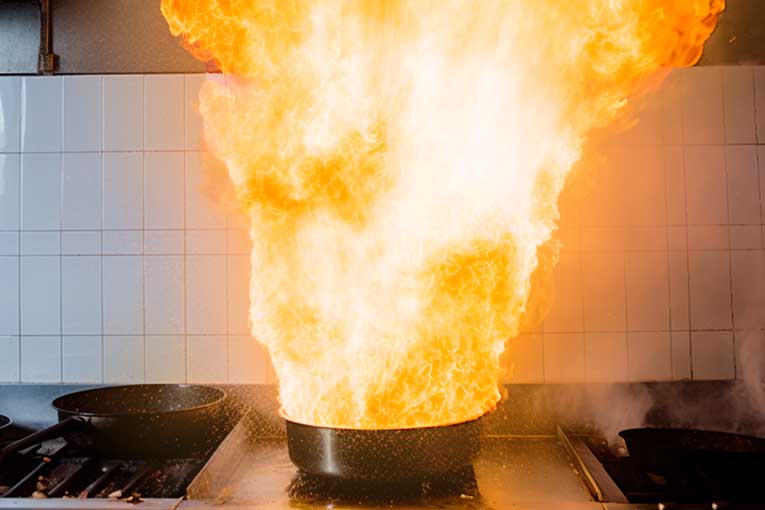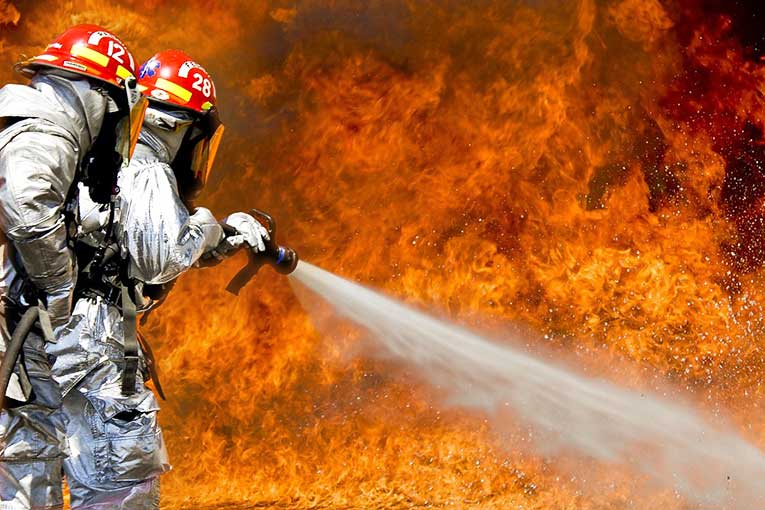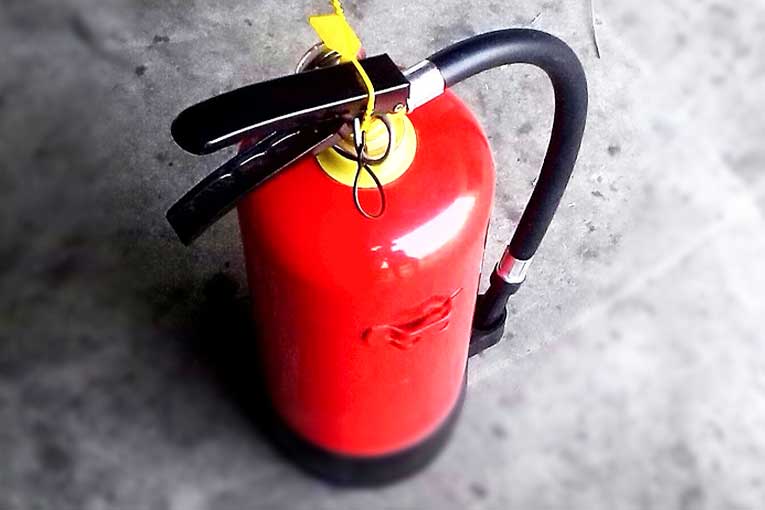How to Put Out a Grease Fire
- January 7, 2024
- 8:00 am


Simon Burge
Share this content
Cooking can be an enjoyable and rewarding experience, but it also comes with its fair share of risks.
One of the most common and potentially dangerous kitchen mishaps is a grease fire.
Knowing how to put out a grease fire is not just valuable knowledge; it could be life-saving.
In this article, we will explore the causes of grease fires, the best ways of how to put out a grease fire, and crucial prevention tips to keep your kitchen safe.
What Causes Grease Fires

Grease fires, as every cautious cook knows, are the stuff of kitchen nightmares.
It’s essential to comprehend their origins to prevent potential disasters and kitchen fires.
Overheating
At the heart of a grease fire lies the peril of overheating.
When oil or grease in a pan is heated beyond its smoke point — the temperature at which it begins to emit smoke and break down — it becomes a volatile hazard.
As the heat intensifies, the oil’s molecules break apart, and if not attended to, they ignite, turning a simmering pot into a raging inferno.
This scenario is particularly common when deep frying, where oils are heated to high temperatures for cooking various delicacies.
Water
Another common catalyst for grease fires is the introduction of water.
Imagine a sizzling pan filled with hot oil; a splash of water is akin to tossing a lit matchstick into a powder keg.
When water meets hot grease, it doesn’t simply douse the fire; instead, it fuels it exponentially.
The water sinks to the bottom of the pan, where it evaporates instantly due to the extreme heat.
This rapid conversion of water to steam propels flaming grease droplets into the air, spreading the fire like a frenzied dance of danger.
Other Liquids
While water is the most notorious culprit, other liquids can also lead to disaster.
Sauces, marinades, or even frozen foods with ice crystals can cause spattering when they come into contact with hot oil.
These seemingly harmless elements, when introduced recklessly, can instigate a grease fire, transforming a calm cooking environment into a chaotic emergency.
Dirty Appliances
Dirty stoves, ovens, and exhaust hoods can also be unwitting accomplices.
Grease buildup in and around these appliances serves as additional fuel.
Over time, this accumulated grease can ignite from a simple spark or even the heat of nearby cooking.
Thus, regular cleaning and maintenance are not just aesthetic concerns but crucial safety measures to prevent the unexpected eruption of a grease fire.
How to Put Out a Grease Fire
If a grease fire ignites, it’s crucial to act swiftly and correctly as grease fires are one of the most dangerous types of fire.
Never use water to extinguish a grease fire; water and oil don’t mix and can lead to explosive results.
Instead, follow these steps:
Turn Off the Heat
The moment a grease fire erupts, your first action should be swift and decisive: turn off the heat source immediately.
By removing the fire’s fuel supply, you halt its potential escalation.
This simple act can prevent a small flare-up from spiralling into a major conflagration.
Covering the Pot
A metal lid or a baking sheet is your ally in combating a grease fire.
Place it over the pot with precision, ensuring it entirely covers the flames.
This makeshift shield serves a crucial purpose: it denies the fire access to oxygen, an element essential for combustion.
While using a lid, avoid using a glass one; the intense heat can cause it to shatter, creating an additional hazard.
Baking Soda
For small, manageable fires, a common kitchen ingredient can prove to be a lifesaver: baking soda.
Carefully and evenly sprinkle baking soda over the fire.
Baking soda, also known as sodium bicarbonate, disrupts the chemical reaction of the fire, acting as a smothering agent.
Keeping a box of baking soda within arm’s reach of your stove ensures that you have an immediate and effective countermeasure for minor grease fires.
Using a Fire Extinguisher
When a grease fire defies initial attempts at control, a specialised tool becomes essential: the Class F fire extinguisher.
Specifically designed for kitchen fires, this extinguisher contains a special extinguishing agent that swiftly suppresses grease fires.
Hold the nozzle, aim it at the base of the fire, and sweep it from side to side.
Proper usage can rapidly diminish the flames, preventing further spread.
Prioritise Safety

If, despite your efforts, the grease fire persists and grows, it’s imperative to prioritise safety above all else.
Immediately evacuate the premises and call the fire department.
Firefighters are trained professionals equipped to handle even the most severe kitchen fires.
Do not attempt to be a hero in such situations; your safety and the safety of those around you is paramount.
Why are Grease Fires so Dangerous
Grease fires are not just ordinary flames; they are a volatile combination of intense heat, rapid escalation, and unsuspecting triggers.
Understanding why these fires are so perilous is crucial for everyone, as it can be the key to preventing and managing them effectively.
Rapid Escalation
The alarming characteristic of grease fires lies in their speed of escalation.
Unlike some other fires that begin with a slow burn, a grease fire can transform from a minor sizzle to a raging inferno within seconds.
The flammable nature of grease, coupled with the high temperatures used in cooking, creates a volatile mix.
A mere distraction can lead to a small spill catching fire, and within moments, the entire kitchen can be ablaze.
This swift escalation demands immediate, well-informed action to prevent the situation from spiralling out of control.
Unpredictable Expansion
What makes grease fires especially hazardous is their tendency to spread rapidly and unpredictably.
Once ignited, the flames can swiftly engulf nearby items, including kitchen towels, curtains, or even cabinets.
This rapid spread not only intensifies the danger but also makes it challenging to contain the fire within its initial source.
In moments of chaos, the fire can leap from the stove to nearby surfaces, turning a localised incident into a kitchen-wide catastrophe.
Severe Burns and Property Damage
The high temperatures generated by grease fires pose significant risks to human safety.
Anyone attempting to intervene without proper knowledge or equipment is at risk of severe burns.
In worst-case scenarios, these burns can be life-threatening.
Moreover, the intense heat can cause extensive damage to property.
Cabinets, appliances, and kitchen structures can succumb to the flames, leading to costly repairs and emotional distress.
It’s not just about extinguishing the fire; it’s about mitigating the aftermath, which can be devastating both physically and emotionally.
The Water Trap
A critical aspect that renders grease fires exceptionally dangerous is the widespread misconception regarding their extinguishing methods.
The instinctive reaction for many is to reach for water.
However, this instinct is profoundly misguided. When water meets hot grease, it reacts explosively, splattering burning grease and spreading the fire rather than dousing it.
This misconception, if not corrected, can turn a controllable situation into a catastrophic event, magnifying the danger manifold.
What Type of Fire is a Grease Fire

A grease fire falls under the category of a Class F fire.
Class F fires involve cooking oils and fats, making them unique in their behaviour and extinguishing methods.
Class F fires are one of the most dangerous classes of fire.
Regular fire extinguishers might not be effective against grease fires; it’s essential to have a specialised Class F fire extinguisher in your kitchen if you frequently cook with oils.
How to Prevent Grease Fires
Preventing a grease fire is far simpler than dealing with one.
Here are some essential tips to keep your kitchen safe:
Stay in the Kitchen
Never leave the stove unattended while cooking.
If you must leave, turn off the heat.
The smallest distraction can transform a simmering pot into a raging inferno.
Be Prepared
Preparedness is key.
Every kitchen should be armed with a fire extinguisher and a trusty box of baking soda.
Familiarise yourself with their usage.
These tools are your first line of defence, swiftly neutralising a grease fire’s threat before it escalates.
Knowing how to handle them can mean the difference between a minor mishap and a catastrophe averted.
Keep the Area Clean
A clean kitchen is a safe kitchen.
Regularly scrub your stovetop, oven, and exhaust hood to banish grease buildup, the combustible culprit behind many a kitchen blaze.
Grease, when left unchecked, can turn a simple cooking session into a disaster.
Your diligent cleaning rituals act as a shield, guarding against unexpected conflagrations.
Use a Thermometer
Temperature control is an art in cooking, especially when it comes to oils.
Invest in a kitchen thermometer to monitor your oils’ temperatures closely.
Oils have smoke points, beyond which they become highly flammable.
By keeping your oils below these thresholds, you ensure you can stay safe.
Dry Before Cooking
Before introducing items to hot oil, ensure they are dry.
Water droplets, when introduced to sizzling oil, create explosive splatters.
These splatters not only pose burn risks but can also ignite surrounding surfaces.
A simple pat-down of the items you’re frying ensures that your oil remains calm, reducing the risk of sudden, dangerous flare-ups.
Don’t Overcrowd the Pan
Avoid overcrowding the pan when frying.
Overcrowded pans lead to spills, creating a hazardous situation where hot oil can spill onto open flames or heating elements.
A controlled, appropriately filled pan ensures that your cooking stays safe, without the drama of a sudden fire.
Conclusion
Being aware of the causes, dangers, and prevention methods of grease fires is essential for anyone who spends time in the kitchen.
By following these safety guidelines and acting promptly and correctly if a grease fire occurs, you significantly reduce the risk of a minor kitchen incident turning into a disaster.
Remember, caution and preparedness are your best allies when it comes to keeping your kitchen and home safe.

